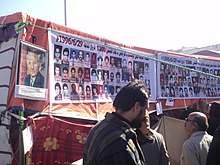Abu Salim prison
The Abu Salim Prison ( Arabic سجن أبو سليم, DMG Siǧn Abū Salīm ) was a maximum security prison in Abu Salim near Tripoli in Libya , in which many political prisoners were detained and which, according to human rights organizations, was notorious for torture . It was made known through a massacre in June 1996.
The prison was used until Tripoli was conquered by the Libyan National Liberation Army in late August 2011 in the wake of the 2011 civil war . After the capture, the guards left the premises and the prisoners were free to leave the prison.
Massacre on 28/29 June 1996
course
After numerous skirmishes between the Libyan Islamic Fighting Group and Libyan security forces in eastern Libya since June 1995 , numerous fighters from this organization were imprisoned in Abu Salim prison.
Due to the poor conditions of detention, a revolt broke out among the prisoners on June 28, 1996, during which two guards were taken hostage. One of them died in the process. As a result, the security forces allegedly carried out a massacre of the inmates, who mainly came from Benghazi , on the orders of the then head of the secret service, Abdullah as-Sanusi .
Initially, the rebellious prisoners are said to have been persuaded to give up in negotiations. After the uprising was over, the inmates of all prison blocks involved in the uprising were said to have been separated from the other prisoners on June 29 and then shot by a special unit. It is estimated that around 1200 of the 1600 to 1700 prisoners at the time died in the prison.
Work-up
Beginning in 2001, the authorities informed some families of prisoners about their deaths without giving them the cause of death. In April 2004, head of state Muammar al-Gaddafi first publicly admitted that prisoners had been killed. In 2007, relatives of prisoners began demonstrating in Benghazi to demand an investigation into the events and the retrieval of the bodies.
An initial investigation into the incidents did not take place until 2009 and could not make any progress due to the immunity of the state security officers. The then Justice Minister Mustafa Abd al-Jalil is said to have campaigned for an investigation.
One complex was torn down in April 2010, believed to be to cover up traces of the massacre.
On February 15, 2011, security forces arrested lawyer Fathi Terbil . He represented numerous victims of the massacre and had also lost two family members. Thousands of demonstrators took to the streets for him in Benghazi. These rallies are seen as an important trigger for the 2011 civil war.
In September 2011, investigators from the Libyan Transitional Council claimed to have found a mass grave from 1996 with more than 1200 corpses doused with acid. Both Jamal Ben Noor from the Justice and Human Rights Ministry of the Libyan Transitional Council and a CNN team that was there spoke of "bones that are too big for human conditions" and "animal bones". Neither of them mention anything about the use of acid.
Former inmates
- Ahmed al-Senussi (1984-2001)
- Abd al-Hakim Balhaj (2004-2010)
- Abdel Hamid Schukri , Muslim Brotherhood activist
- Abu Sufian bin Qumu (2007-2010, former Guantanamo prisoner)
- Matthew VanDyke (2011), American Civil War volunteer
Web links
- Inga Rogg: A Libyan nightmare without end. A former prisoner about the infamous Abu Salim prison in Tripoli. In: Neue Zürcher Zeitung . September 27, 2011, accessed on September 27, 2011 (Ahmed Busifi, a prisoner at the time, reports on his time in Abu Salim prison and on the massacre).
- Libya: June 1996 Killings at Abu Salim Prison. (PDF; 184 kB) Human Rights Watch , 2003, accessed October 25, 2011 .
Individual evidence
- ↑ a b Martin Gehlen: Gaddafi's highest enemy. In: Frankfurter Rundschau . March 9, 2011, accessed March 10, 2011 .
- ↑ Retribution for Revolt. In: ORF . September 26, 2011, accessed September 26, 2011 .
- ↑ Daniel Byman: It's a fight against al-Qaida too, March 30, 2011
- ↑ Mass grave with 1200 bodies. In: the daily newspaper . September 25, 2011, accessed September 27, 2011 .
- ↑ a b Human Rights Watch: Libya: June 1996 Killings at Abu Salim Prison , June 27, 2006
- ^ Jo Becker, Human Rights Watch: Events of 2 years ago sparked current uprising in Libya , 2011
- ↑ Rachid Khechana: The three robes of Colonel Gaddafi. In: Le Monde Diplomatique . April 8, 2011, accessed September 25, 2011 .
- ↑ A Libyan Nightmare Without End. In: Neue Zürcher Zeitung. September 27, 2011, accessed September 27, 2011 .
- ↑ Rachid Khechana: soulèvement contre la bédouinocratie et son chef. In: Le Monde Diplomatique . April 2011, accessed September 25, 2011 (French).
- ↑ Mass grave discovered with 1,200 bodies. Retaliation for revolt. , September 26, 2011
- ↑ CNN Wire Staff: Libya hedges mass grave claim. In: CNN . September 26, 2011, accessed December 22, 2011 .
- ↑ Petra Ramsauer : Jihadists gain influence in Tripoli. In: The time . February 29, 2012. Retrieved February 29, 2012 .
Coordinates: 32 ° 50 ′ 0 ″ N , 13 ° 10 ′ 26 ″ E
